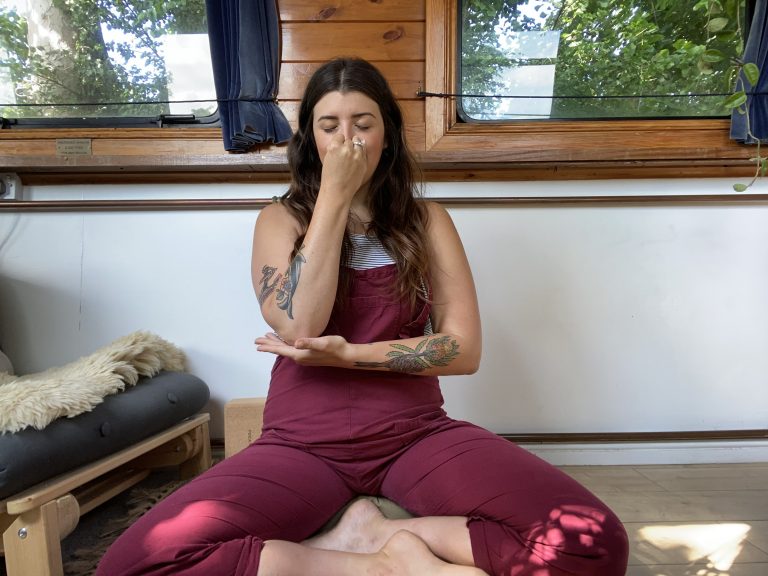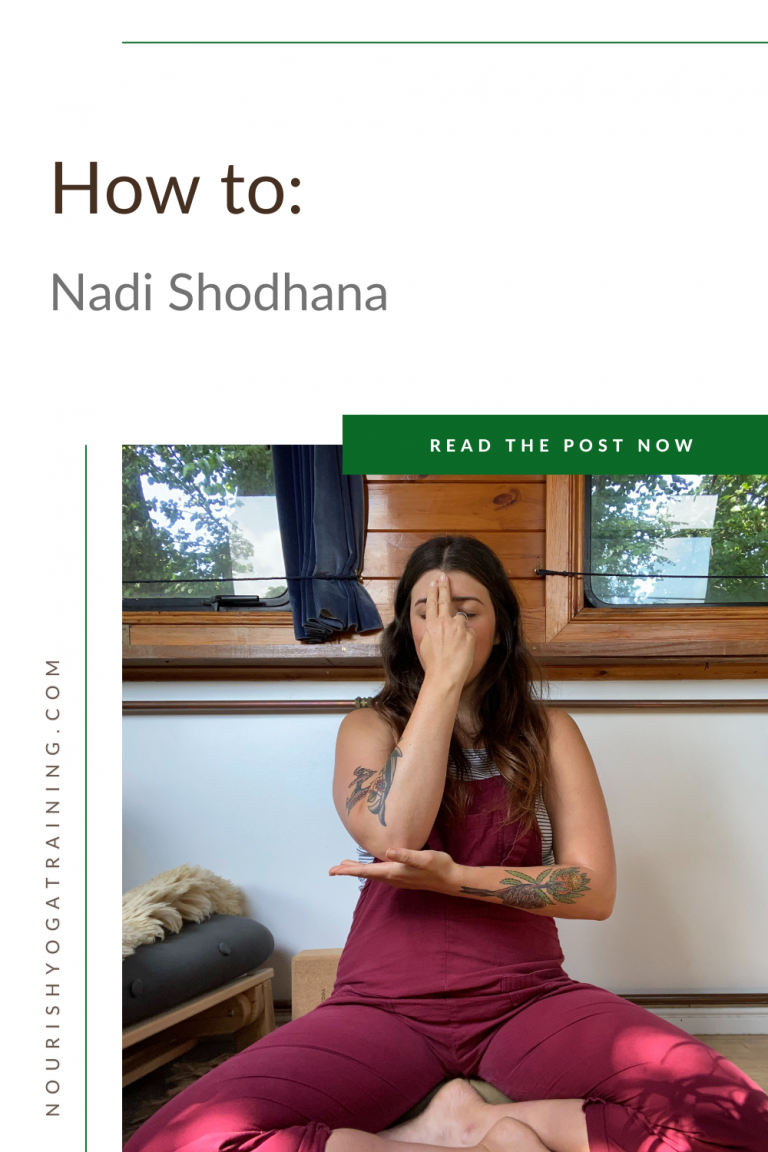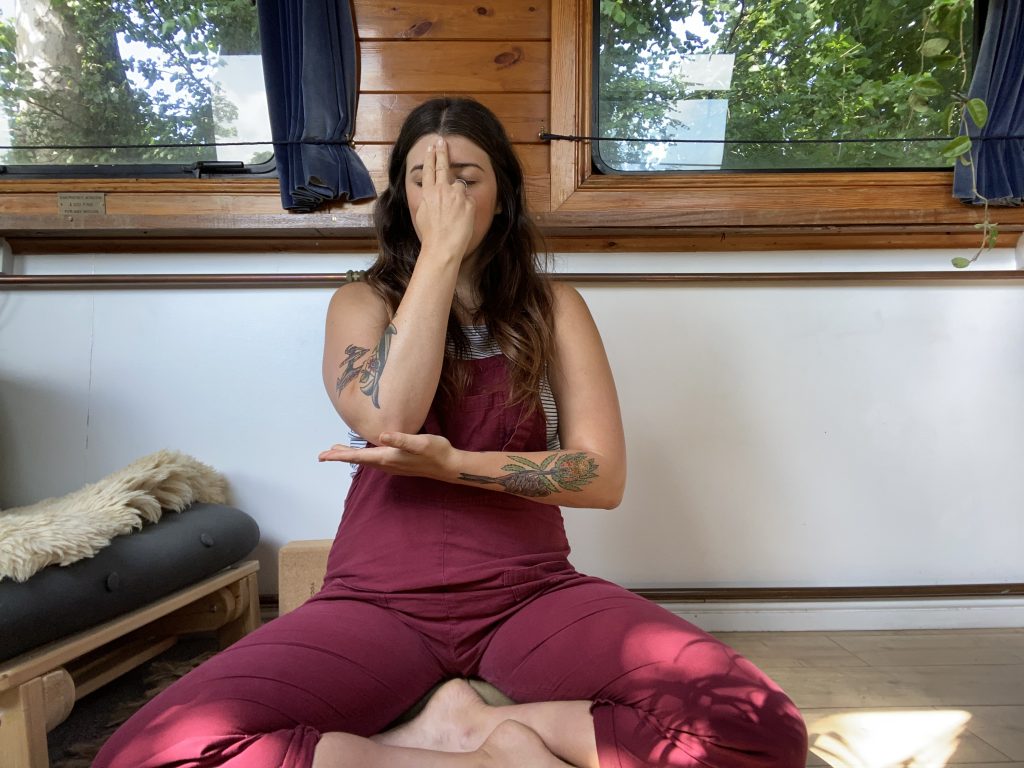This is part of Nourish’s Yoga Practise Guide Library. We were inspired to make these guides to support your own yoga practise and as a resource for teachers who want to make their classes more accessible. We were also pretty tired of all the generic teaching instructions and guides floating around the internet that aren’t inclusive, accessible or adaptable in any way.
If you would like more guidance on making this practice accessible, we have missed something, or you have any questions drop us a comment –– we love hearing from you and really do mean it when we say yoga is for everybody!
If you’re curious and want to dive right in, skip to the end of the post where we share a recording of Harriet leading a loving-kindness meditation for you to try.
What is Nadi Shodhana?
Nadi Shodhana is a largely accessible pranayama (breathing) practice, intended to have a calming and balancing effect. The name is translated into English as Alternate Nostril Breathing, as during the practice, you alternate your inhalation and exhalation through the left and right nostrils.
The Sanskrit word Nadi means tube or channel, pertaining to the energetic network of channels that carry prana through the body, and Shodhana means purifying. From a yogic energetics perspective, Nadi Shodhana is considered to be a practice that purifies, unblocks, or balances the energetic dynamics of the body, allowing for a smooth flow of prana.
The physiological effects of Nadi Shodhana have also been assessed in scientific studies. Studies report increased activation of the parasympathetic nervous system (the ‘rest and digest’ or relaxation response) with regular practice, as well as a reduction in blood pressure for people with high blood pressure and improved dexterity in the hands. It is important to note, as is the case with these studies, that a majority of the research conducted on yoga is in small population sizes and limited demographics, therefore we cannot assume these effects will be true for everybody.
You may connect to the energetic explanation, or you may not. You may be interested in the scientific studies, or you may not. You may conclude that the energetic and physiological effects can be mapped on to each other, or you may not. There is no best theoretical way to approach or make sense of the practice. What is significant, however, is noticing and exploring how the practice affects you — physically, emotionally, and psychologically — and encouraging your students to do the same.
Nadi Shodhana or Anuloma Violma?
Alternate Nostril Breathing is also sometimes called Anuloma Violma (Sanskrit: Anuloma = with the grain, Viloma = against the grain). So, is there a difference between Anuloma Viloma and Nadi Shodhana?
Although there are many different explanations available for distinguishing between the practices, regarding the length, depth, retentions of the breath, and whether you inhale or exhale through one or both nostrils, there is no commonly agreed-upon distinction. Depending on which resource you consult, you will find different reasonings and variations that fall under the names Nadi Shodhana and Anuloma Viloma.
The most likely reason why this is the case is that yoga has never been a uniform tradition. Yoga has always consisted of many lineages that have passed down their philosophies and practices primarily orally. There has always been different interpretations and teachings of the various yoga practices. Not only do practices vary between traditions, but they also may have been adapted within the tradition to serve the needs of individual students.
In short, it is near enough impossible to pin down a clear difference between Anuloma Viloma and Nadi Shodhana, hence why the two names are used interchangeably for the same practice.
In this guide, we use the name Nadi Shodhana and explore different variations of the practice. However, if you have been taught within a specific lineage that uses another name or draws clear distinctions between Nadi Shodhana and Anuloma Violma, you can use the name you prefer. What we believe to be of most importance is finding a variation of the practice that works best for each individual.
Nadi Shodhana Suggestions and Variations
Setting Up
Step One: Find a comfortable seated position. This can be on a chair, kneeling, or cross-legged on a block or cushions.
Lengthen the spine as much as possible, let the shoulders and belly be soft. Creating a lengthened, open, and soft torso is helpful for pranayama practices as it enables the breath to move freely and deeply in and out.
If your breath feels short or restricted, you may want to take a few rounds of three-part breath to find depth and softness.
Step Two: Set up your hands. You will use your dominant hand to open and close the nostrils, by using a mudra called Nasagra mudra (Sanksrit: Nasagra = nose tip, mudra = seal) shown in the leading picture above.
Hold your dominant hand palm facing up out in front of you and spread the fingers, then gently squeeze the index and middle finger together and the ring and pinky finger together (if you watch Star Trek it looks like the Vulcan salute). Rest your index and middle fingers on your third eye, the space between your eyebrows. Then rest your thumb on one side of the bridge of your nose on the bony ridge. Slide your thumb down to the soft part just beneath the ridge, and gently squeeze to close off your airway. If you push firmly, you will feel that you can close it off completely, but you can also push softly to leave a slight opening. Repeat this step with the ring and pinky finger on the other side (the ring finger does the closing action against the nose, and the pinky finger rests alongside it).
Now you can control whether you close off each airway entirely or leave a slight opening.
Rest your other hand, palm facing up or down on your lap.
A few notes on your hands…
- Please use the hand you feel most comfortable with to control the opening and closing of your airways. There is no reason why it needs to be the right hand. You can even switch it up in your practice from day to day, it doesn’t make a difference.
- Some people prefer to rest their fingers just above their nostrils, and close off their airways there — that is fine. Whatever is most comfortable for you.
- Another commonly used hand gesture is Vishnu mudra (below). This is almost exactly the same as Nasagra mudra, but instead of resting your index and middle finger between the eyebrows, you fold them into the palm of your hand. Again, use whichever is most comfortable for you.

The Practice
There is no set length for the inhale or exhale, but try to establish a comfortable, gently lengthened, equal rhythm that feels natural to you.
Step Three: With your hands in place, take a few even breaths through both nostrils.
Step Four: Close off your right nostril (this will be with your thumb if you are using your right hand or your ring-pinky finger if you are using your left hand), and inhale through your left nostril. You can visualise breathing up to the space between your eyebrows if you like.
Step Five: Next, simultaneously, close off your left nostril and release your right nostril. As soon as the right nostril is open, exhale through it. Perhaps visualising the breath coming from the space between your eyebrows.
Step Six: Keep the left nostril closed, and inhale through the right.
Step Seven: Close the right and release the left, exhale through the left. This is one round.
Step Eight: Repeat for five rounds, or however many rounds are comfortable for you.
Breath Variations
2:1 Breath Ratio
For this variation, you double the length of the exhale relative to the inhale. So, for example, if you inhale for a count of three, you exhale for a count of six. There is no correct length, but it is important not to strain the breath by making the count too long — so find one that works for you.
The elongated ratio can feel extra soothing or relaxing, as a longer exhale often equates to increased parasympathetic nervous system stimulation. However, if it doesn’t feel right for you, return to a variation that feels more welcoming.
Hands-Free Variation
This variation is a great alternative to explore if you have limited hand mobility or co-ordination, un-even air passages in your nose (such as if you have a deviated septum), or if you want a more restful variation you can do lying down. It takes a little more focus, and it’s normal to breathe through both nostrils as you do it (although you may be able to direct the breath partially or completely through one nostril), but it has a lovely meditative quality to it.
- Find either a comfortable seat or lie down on your back, and rest your hands in a comfortable position.
- As you inhale, focus on drawing the breath up through your left nostril to the space between your eyebrows. As you exhale, focus on exhaling through your right nostril. As you inhale, focus on drawing the breath through your right nostril. As you exhale, focus on exhaling through the left nostrils. This is one round.
- Repeat five times, or more if you like.
When Do I Practice Nadi Shodhana?
Nadi Shodhana can be practised by itself when you need a few minutes of respite, or it can be integrated into a practice with other pranayama exercises. As it is considered a balancing practice, it’s a lovely way to prepare or wind down from other more dynamic pranayama practices, such as Kapala Bhati or Bhastrika. It’s also a great transition practice into meditation.
You can practice it any time of day, just explore what feels right. Some people find it helps them sleep or unwind at the end of the day, and other people find it helps balance them in the morning or throughout the day.
If you are a yoga teacher, you could teach it at the end of a more dynamic class before Shavasana. Or the start or end of a Yin or Restorative class.
When Shouldn’t I Practice or Teach it?
Not every pranayama practice is for everybody, so if you don’t connect to the practice — particularly if it makes you feel anxious, panicked, lightheaded, or triggers headaches, then this isn’t the practice for you. Try exploring other pranayama practices or aspects of yoga instead. Sometimes when we return to a practice at a later date it feels more welcoming.
The other major caveat is when you have a blocked nose, as closing off your unblocked nostril means you can’t breathe. Sometimes blowing your nose beforehand does the trick, but you might prefer to skip it entirely until your cold passes.
If you or your student has a deviated septum, or something else that restricts their air passage through one side of the nose, then Nadi Shodhana can feel uncomfortable or frustrating as it exacerbates an existing breathing restriction. You may find that not closing off the nostrils entirely feels more comfortable, or the hands-free variations could also be a good alternative. Otherwise, skip it entirely and focus on pranayama practices that don’t restrict the air passages.
As with all yoga practices, listen to your experience as you practice. If it doesn’t feel right, then modify or pick a different practice.
How Do I Adapt Nadi Shodhana To Make it Accessible? What Are Some Common Difficulties?
- Resist prescribing set lengths for the breath (e.g. inhale for a count of 4, exhale for a count of 6). Encourage students to connect to the quality of the breath — smooth, slightly lengthened, comfortable — and find a rhythm that works for them. Some students may struggle and force their breath if you state a set length, or they may spend more time focusing on the counts of the breath than their experience of the practice.
- Nadi Shodhana is considered a more accessible pranayama practice, generally safe for the majority of people, however, this doesn’t mean that you should assume it will be appropriate for you or your students. As working with the breath impacts the nervous system, which is often sensitive and reactive for people with certain chronic health conditions or who have experienced trauma, the effects of the practice may be unexpectedly challenging and unwelcoming.
- Avoid creating expectations around the practice, e.g. ‘this practice will balance your nervous system’, or ‘this practice is great for relaxation’. Instead, focus on what the practice is actually like for you (and encourage your students to do the same), noticing physical, psychological, and emotional impacts. Experiences can range from neutral, pleasant, unpleasant, to no changes.
- The mudra and co-ordination of the hand often throws people off at the beginning. Spend some time getting familiar with it before starting the practice.
- Often you will hear that the right hand should be used for the mudra. There is no good reason why this is the case and is unfair to people who are left-handed, have mobility limitations in their right hand, or have an amputated right hand. Focus instead on which nostril is opening or closing, as opposed to the action of the thumb or ring-pinky finger.
- Pranayama practices can feel more unnatural than asana, as working with the breath is less common than working with the body. Therefore, it is not uncommon for pranayama to feel intimidating. Take some time to get familiar with the dynamics of the practice before trying it out, and start slow, with just a few rounds and build as familiarity and confidence develops.
- For anybody, working with the breath can feel confrontational and anxiety-inducing. It is often said that this practice helps with anxiety, but that it is a pretty reductive view. For some it may help, for others it may exacerbate or trigger it. If you have any unwelcome experience, ranging from panic to unwanted sleepiness, then just stop.
- Generally, this practice is done seated, but if you want to do a reclined variation, or offer a reclined option to your students, the hands-free variation is ideal for this.
How Do I Teach Nadi Shodhana To A Mixed Ability Class?
- Take your time to explain the practice first, even if you have students who are familiar with it in the class. It doesn’t harm students to be refreshed on the practice (they may even learn something new), and a proper explanation is essential for students who are new or only slightly familiar with the practice or pranayama in general.
- Remind students that they can stop at any time if it doesn’t feel right. Give students the option to sit quietly until the practice is over, lie down, or leave the studio to get a drink of water or go to the bathroom if they are finding the breathwork uncomfortable or overwhelming.
- Leave at least ten minutes for the practice, this gives enough time to explain the practice and practice five rounds. If you are planning to introduce the 2:1 ratio or explain the hands-free variation, leave at least 15 minutes.
- Emphasise your students’ agency when it comes to determining the length of their breath, whether they introduce the ratio, and for how many rounds they want to practice. This is all part of encouraging your students to foster a healthy and positive relationship with pranayama.
- Hold off teaching retentions in a class setting. Without intimate knowledge of your students’ experience with Nadi Shodhana, introducing retentions can be an unwelcome experience. The exception to this would be in a retreat setting with a group of students who have an established pranayama practice and with whom you have been practising for a few days.
- Encourage your students to stay present with their experience and how the practice impacts them. This gives them the agency to modify their practice and moves away from prescriptive experiences.
- Stress that there is no right way to feel as a result of the practice. Although the practice may be considered calming and balancing, and there is some evidence for its parasympathetic nervous stimulating effects, these are not givens. Sometimes we feel nothing when we practice, and sometimes we feel the opposite of what we have been told to expect.
We always love to hear from our community, let us know if you practice or teach Nadi Shodhana and any insights that you feel are of value! Of course, if we have missed anything, or you know an alternative variation we haven’t included, please also share.
Pin for later

